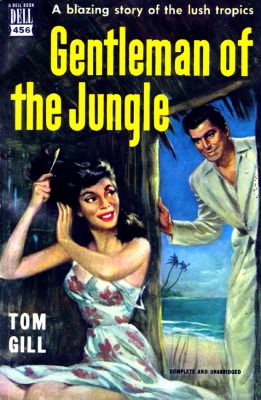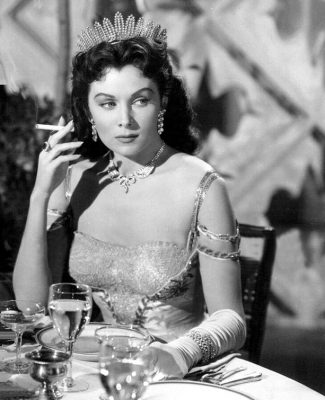SERPENT OF THE NILE (1953) by William Castle [english]
The SERPENT OF THE NILE Files
Films with Rhonda Fleming that have not yet been released in good quality on DVD or Blu-ray are presented in the “Files”
Historical facts:
Cleopatra, (Greek: “Famous in Her Father”) in full Cleopatra VII Thea Philopator (“Cleopatra the Father-Loving Goddess”), (born 70/69 bce—died August 30 bce, Alexandria), Egyptian queen, famous in history and drama as the lover of Julius Caesar and later as the wife of Mark Antony. She became queen on the death of her fatherPtolemy XII, in 51 bce and ruled successively with her two brothers Ptolemy XIII (51–47) and Ptolemy XIV (47–44) and her son Ptolemy XV Caesar (44–30). After the Roman armies of Octavian (the future emperor Augustus) defeated their combined forces,  Antony and Cleopatra committed suicide, and Egypt fell under Roman domination. Cleopatra actively influenced Roman politics at a crucial period, and she came to represent, as did no other woman of antiquity, the prototype of the romantic femme fatale … Many actresses, including Theda Bara (1917), Claudette Colbert (1934), and Elizabeth Taylor (1963), have played the queen, typically in expensive, exotic films that concentrate on the queen’s love life rather than her politics. Meanwhile, Cleopatra’s seductive beauty—a seductive beauty that is not supported by the queen’s contemporary portraiture—has been used to sell a wide range of products, from cosmetics to cigarettes. In the late 20th century Cleopatra’s racial heritage became a subject of intense academic debate, with some African American scholars embracing Cleopatra as a black African heroine. (Britannica.com)
Antony and Cleopatra committed suicide, and Egypt fell under Roman domination. Cleopatra actively influenced Roman politics at a crucial period, and she came to represent, as did no other woman of antiquity, the prototype of the romantic femme fatale … Many actresses, including Theda Bara (1917), Claudette Colbert (1934), and Elizabeth Taylor (1963), have played the queen, typically in expensive, exotic films that concentrate on the queen’s love life rather than her politics. Meanwhile, Cleopatra’s seductive beauty—a seductive beauty that is not supported by the queen’s contemporary portraiture—has been used to sell a wide range of products, from cosmetics to cigarettes. In the late 20th century Cleopatra’s racial heritage became a subject of intense academic debate, with some African American scholars embracing Cleopatra as a black African heroine. (Britannica.com)

SERPENT OF THE NILE is probably one of the most sensual Technicolor films of the entire 1950s. Its storyline: In 44 BC, after Julius Caesar’s assassination by plotters who accused him of being a dictator, a triumvirate of politicians and generals control Rome. The triumvirate is comprised of generals Mark Antony and Lepidus and politician Octavian who is Caesar’s great-nephew and adopted son. They seek to revenge Caesar’s death by  going after the main plotters, senators Brutus and Cassius. Mark Antony and Octavian’s armies destroy those of Brutus and Cassius in battle. Later, Mark Antony and his army embarks on the conquest of Egypt while Octavian remains in Rome. However, the cunning and attractive queen of Egypt, Cleopatra, greets Mark Antony as a friend and lavishes him with praises, feasts, gifts, riches and intimate favors. Impressed, Mark Antony falls in-love with her. Mark Antony spends months on end enjoying the VIP treatment in Cleopatra’s palace in Alexandria, despite warnings from one of his trusted commanders, Lucilius, that Cleopatra is just manipulating him. Cleopatra gets wind of Lucilius’ warnings and first tries to seduce him and later tries to have him killed. He ends up in house arrest in her palace but he’s determined to escape and warn Octavian in Rome. Cleopatra convinces Mark Antony to form an alliance with her and together to fight Octavian for the throne of Rome. Cleopatra suggests that either Mark Antony or her own young son should become ruler of Rome. Her son is also Julius Caesar’s son from Caesar’s past marriage to Cleopatra. Fed-up with Mark Antony’s refusal to ditch Cleopatra and return home to Rome, Octavian dissolves the triumvirate and dismisses Lepidus. Commander Lucilius escapes from Egypt and returns to Rome to warn Octavian and the Roman Senate about Cleopatra and Mark Antony’s military alliance. Octavian forms an army and invades Egypt. Cleopatra and Mark Antony prepare their united forces but they understand that losing the war against Octavian could spell their end. (imdb.com)
going after the main plotters, senators Brutus and Cassius. Mark Antony and Octavian’s armies destroy those of Brutus and Cassius in battle. Later, Mark Antony and his army embarks on the conquest of Egypt while Octavian remains in Rome. However, the cunning and attractive queen of Egypt, Cleopatra, greets Mark Antony as a friend and lavishes him with praises, feasts, gifts, riches and intimate favors. Impressed, Mark Antony falls in-love with her. Mark Antony spends months on end enjoying the VIP treatment in Cleopatra’s palace in Alexandria, despite warnings from one of his trusted commanders, Lucilius, that Cleopatra is just manipulating him. Cleopatra gets wind of Lucilius’ warnings and first tries to seduce him and later tries to have him killed. He ends up in house arrest in her palace but he’s determined to escape and warn Octavian in Rome. Cleopatra convinces Mark Antony to form an alliance with her and together to fight Octavian for the throne of Rome. Cleopatra suggests that either Mark Antony or her own young son should become ruler of Rome. Her son is also Julius Caesar’s son from Caesar’s past marriage to Cleopatra. Fed-up with Mark Antony’s refusal to ditch Cleopatra and return home to Rome, Octavian dissolves the triumvirate and dismisses Lepidus. Commander Lucilius escapes from Egypt and returns to Rome to warn Octavian and the Roman Senate about Cleopatra and Mark Antony’s military alliance. Octavian forms an army and invades Egypt. Cleopatra and Mark Antony prepare their united forces but they understand that losing the war against Octavian could spell their end. (imdb.com)
In the press:
Quotes:
Rhonda Fleming:
„I have to admit, I was disappointed when I first saw the finished film. And I wasn’t to happy with the way I played the role. There was not enough variety in Cleopatra’s  emotions for me to add my performance … The distant painted scenes were definitely not good, very likely due to the low budget. Bill Castle, however, did an incredible job despite the limitations of the production. However, the Technicolor was beautiful and my costumes by Jean Louis were lovely“ (2014).
emotions for me to add my performance … The distant painted scenes were definitely not good, very likely due to the low budget. Bill Castle, however, did an incredible job despite the limitations of the production. However, the Technicolor was beautiful and my costumes by Jean Louis were lovely“ (2014).
William Lundigan:
„I have one love scene that has more romance than I’ve had in my last two or three pictures. As for beefcake, I’m not knocking it“ (Aug. 1952).
Jordan Hoffman:
“But there are certainly delights to be found from her run. Serpent of the Nile, in which she plays Cleopatra opposite Raymond Burr as Mark Anthony, is almost a laboratory-made example of B-picture perfection” (Vanity Fair, Oct. 17, 2020).
The SERPENT OF THE NILE Gallery:
Click on thumbnails to see gallery
SERPENT OF THE NILE
(German title: Die Schlange vom Nil)
USA 1953 (Sam Katzman Productions/Columbia Pictures), 81 min., 35 MM (1.37:1), Technicolor.
Producer: Sam Katzman; Director: William Castle; Screenplay: Robert E. Kent; Cinematography: Henry Freulich; Technicolor Color Consultant: Francis Cugat; Editor: Gene Havlick; Music: Mischa Bakaleinikoff; Art Direction: Paul Palmentola; Set Decoration: Sidney Clifford; Special Effects: Jack Erickson; Make-up: Anatole Robbins; Costume Design: Jean Louis.
Cast: Rhonda Fleming (Cleopatra), William Lundigan (Lucilius), Raymond Burr (Marcus Antonius), Jean Byron (Charmian), Michael Ansara (Captain Florus), Michael Fox (Octavius), Julie Newmar (The Gilded Girl), Fred F. Sears (Off-Screen Narrator), and others.
Premier: May 8, 1953; US box office rank (in the year of release): 192; US domestic actual box office grosses: $1 million.
Hits: 1241


 Rhonda Fleming for TROPIC ZONE, the last of the four films under her first contract with them. “The tropics where blood runs hot” promises the new edition from Dell Publishing Company, and continues: with a price on his head and the hand of the world against him, a down-and-out young beachcomber is forced into a treacherous conspiracy against a lovely girl who operates a banana plantation in a Central American republic. There is quality in the man and he meets the chalenge squarely. Fighting tremendous and dangerous odds, he blazes his way along a twisty path of breath-taking adventure and flaming romance to win an exciting duel of wits.
Rhonda Fleming for TROPIC ZONE, the last of the four films under her first contract with them. “The tropics where blood runs hot” promises the new edition from Dell Publishing Company, and continues: with a price on his head and the hand of the world against him, a down-and-out young beachcomber is forced into a treacherous conspiracy against a lovely girl who operates a banana plantation in a Central American republic. There is quality in the man and he meets the chalenge squarely. Fighting tremendous and dangerous odds, he blazes his way along a twisty path of breath-taking adventure and flaming romance to win an exciting duel of wits.
 head, crookedly controls the independent growers via his export power. Dan McCloud (Ronald Reagan) lands in the place on a plane pilofied by Tapachula Sam (Noah Beery), and accompanied by entertainer Elena (Estelita), who is in love with him. Lukats hires McCloud to serve as foreman for Flanders but his real job is to disrupt Flanders’ operations, now managed by Bert Nelson (Grant Withers). Instead, McCloud falls in love with Flanders. Action in the outdoor Technicolor adventure drama boils when McCloud goes about exposing Lukats, reaches an exciting climax (from the press book by Paramount Pictures).
head, crookedly controls the independent growers via his export power. Dan McCloud (Ronald Reagan) lands in the place on a plane pilofied by Tapachula Sam (Noah Beery), and accompanied by entertainer Elena (Estelita), who is in love with him. Lukats hires McCloud to serve as foreman for Flanders but his real job is to disrupt Flanders’ operations, now managed by Bert Nelson (Grant Withers). Instead, McCloud falls in love with Flanders. Action in the outdoor Technicolor adventure drama boils when McCloud goes about exposing Lukats, reaches an exciting climax (from the press book by Paramount Pictures).








 „Every hunch in my body told me to say no. I told myself I wasn’t a dancer, and Little Egypt earned her fame by dancing so how could I do the role justice? I said I was a redhead so I couldn’t possibly play a girl with jet black hair. I read the script and realized it was a diffucult acting assignment and doubted that I had the ability to handle the part“ – (Jan. 7, 1951).
„Every hunch in my body told me to say no. I told myself I wasn’t a dancer, and Little Egypt earned her fame by dancing so how could I do the role justice? I said I was a redhead so I couldn’t possibly play a girl with jet black hair. I read the script and realized it was a diffucult acting assignment and doubted that I had the ability to handle the part“ – (Jan. 7, 1951).